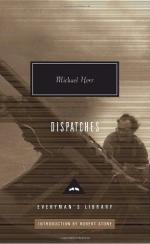|
This section contains 476 words (approx. 2 pages at 400 words per page) |

|
Dispatches Summary & Study Guide Description
Dispatches Summary & Study Guide includes comprehensive information and analysis to help you understand the book. This study guide contains the following sections:
This detailed literature summary also contains Topics for Discussion and a Free Quiz on Dispatches by Michael Herr.
Michael Herr, a writer in his late twenties, takes a correspondent position with Esquire Magazine to report on the Vietnam War. He covers two major operations, the siege of Khe Sahn and the recapture of Hue, the old Vietnamese capital, plus several other field operations. He meets many Marines, several officers, and fellow correspondents while gathering the impressions and experiences contained in his dispatches. The author prefers field operations over work in Saigon and its relative safety, but in reality no place is safe in Vietnam. The enemy owns the night with mortar attacks and continues the terror tactics with secretly planted bombs that explode anywhere in the city.
The Vietnam War reaches its pinnacle with the Tet Offensive, named after the lunar new year on which it starts, from January 30, 1968 to June, 1968. Shortly before Tet, the siege of Khe Sanh begins on January 21 and lasts until April, 1968. Herr arrives to Khe Sahn by helicopter, the primary mode of transportation during the war, and meets two Marines with whom he shares a perimeter bunker—Day Tripper and Mayhew—along with other Marines. The author describes how the NVA (North Vietnamese Army) surrounds the base and digs trenches up to the barbed wire lines in preparation for a large-scale assault. Everybody expects something big to happen while the NVA probes the wire regularly in the cover of night and the Marines shoot by the light of mortar-fired flares. Suddenly the NVA leaves the area quickly, apparently from the heavy air strikes taking a larger toll than thought.
Herr tells the Marines' stories, some bizarre and others touching, with a deep sense of respect and admiration for what the young men do and think in a foreign country full of danger. With significantly less admiration, the author relates the propaganda of the Vietnam War and sketches the portraits of those promoting the official lines. While other correspondents think of the Marines as unworthy for story material, Herr finds them all to have something of value. His dispatches concentrate on the men who leave the deeper impressions, the background of the war, and the current action, but he also gives a section of vignettes that round out his overall experience. Sections for the other correspondents finish the book, most notably Page, a British reporter who ends up seriously injured from shrapnel.
Death and mayhem, sardonic humor, and extreme fatigue characterize the Vietnam War, along with legal and illegal drug use, and the ever-present rock and roll. Herr captures the sights, sounds, and gut-wrenching terror of war—plus an unexpected amount of beauty within the ravaged country. The author tells the stories truthfully, as the Marines request and as Herr must. All the filth, stench, and death of war remain as testimonies to what the soldiers experience and the survivors carry back home.
Read more from the Study Guide
|
This section contains 476 words (approx. 2 pages at 400 words per page) |

|



